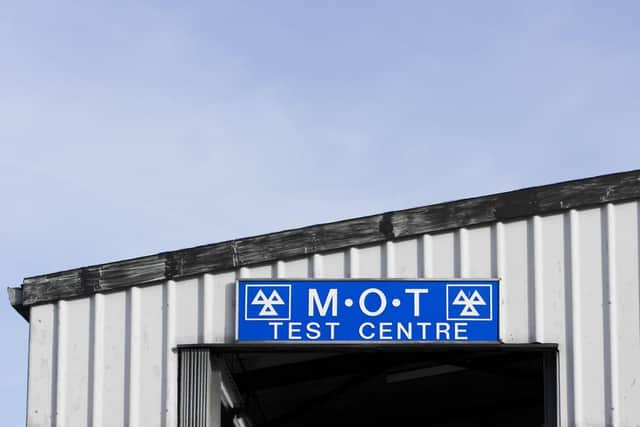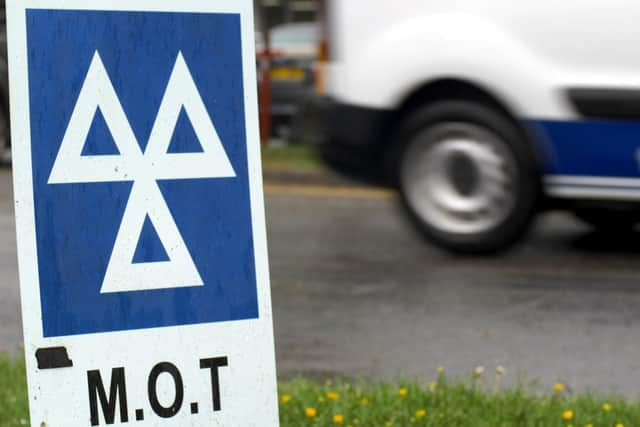When is my MOT due? How to check your car’s MOT status and history, and what to do if your test has expired
and live on Freeview channel 276
The Government is reportedly considering a plan to scrap the annual MOT.
Transport Minister Grant Shapps is rumoured to have suggested switching to a test every two years to help address the cost of living crisis facing families around the UK.
Advertisement
Hide AdAdvertisement
Hide AdAs drivers face soaring fuel and insurance bills and a recent increase in car tax, the move could theoretically save drivers around £27 a year, although the safety implications have been questioned.
For the moment, however, the test remains an annaul requirement for most vehicles and millions of drivers have to present their car for its annual roadworthiness test.
Despite it being a common element of motoring life there’s still a lot of confusion around the MOT, so here we’re answering the most common questions, ranging from how to check your expiry date and what it costs to how long it takes and what it covers.
What is the MOT?
The MOT test is an annual check of a vehicle’s roadworthiness, essentially to ensure that it meets basic standards for safety.
Advertisement
Hide AdAdvertisement
Hide AdDifferent vehicles undergo different tests, with separate categories for cars, motorbikes, and large passenger and goods vehicles.
When is my car's MOT due?


Cars are exempt from the MOT for the first three years of their lives but then must be tested once a year until they reach 40 years old. After this, they are exempt from the MOT, although you can still present them for testing.
Your car’s first MOT will be due on the third anniversary of its first registration and the pass certificate remains valid for 12 months from that date.
You can submit your car for a test up to one month (minus a day) before the current MOT runs out and keep the same renewal date. For example, if your MOT runs out on May 15, the earliest you can get an MOT to keep the same renewal date for next year is April 16. If you take your vehicle for its MOT on April 14 the expiry date changes to April 13 the following year.
Advertisement
Hide AdAdvertisement
Hide AdRemember, if it fails the test before the renewal date, the old certificate is still valid, but the vehicle might not be safe to drive.
How do I check when my MOT is due?
You should be given a paper copy of the pass certificate after each test, which includes the expiry date.
If you’ve lost this or can’t be bothered rummaging around in your filing, the DVSA has a tool for checking your car’s MOT status as well as its MOT and safety recall history.
How much does an MOT cost?
The maximum price a garage can charge for a Class 4 (car) MOT is £54.85, as set by the DVSA (Driver and Vehicle Standards Agency). However, some garages and dealerships will offer cheaper tests as a way to attract customers (and ensure they get their business if any repair work is needed).
How long does the MOT take?
Advertisement
Hide AdAdvertisement
Hide AdThere is no set length of time for an MOT test but, according to MOT specialists Halfords Autocentres, it will typically take between 45 minutes and an hour.
Can anyone carry out an MOT?


No, the test can only be carried out at an accredited MOT testing station and by a qualified MOT tester who has undergone specific training.
All test centres will display the MOT symbol of three intersecting white triangles on a blue background and while they are no longer required to display the qualification certificates of all their MOT technicians many still choose to do so.
What does the MOT cover?
The MOT test looks at the mechanical and electrical operation of your car to ensure it meets certain safety standards.


Advertisement
Hide AdAdvertisement
Hide AdThe test changed in 2018 to include new fault categories and stricter emissions testing.
The technician will either grant a pass certificate or issue a failure notice on the grounds of major or dangerous faults. Minor faults do not constitute a fault but act as an advisory of issues that will need to be addressed soon.
A full list of items checked can be found on the DVSA website but major areas covered include the structural integrity of the vehicle; braking, suspension and steering; fuel system; tyre condition; lighting; exhaust system and emissions; seats; horn and registration plates.
What can I check myself?
Some issues are pretty hard to spot to the untrained eye but many failures are easily avoided.
Advertisement
Hide AdAdvertisement
Hide AdThe 10 most common reasons for MOT failures include issues with lights, tyres, brakes, suspension and visibility. Many of these can be avoided by carrying out some basic maintenance, and the DVSA gives the following list of items it recommends drivers check themselves:
- the windscreen, windows and mirrors are clean
- all lights work
- the brakes work
- engine oil
- water level in the radiator or expansion tank
- brake fluid level
- battery
- windscreen washer fluid level
- tyres - they must have the correct tread depth and be free of cuts and defects
Can I drive a car without an MOT?
No. An MOT is a legal requirement and if you are caught driving a car without a valid MOT certificate you can be fined £1,000.
Despite what some people might tell you, there is no MOT grace period after its expiry date.
The only times you can legally drive without an MOT are if you are driving the car to an MOT testing station to have a pre-booked test carried out, if you are taking it to be repaired, or if the vehicle is more than 40 years old and thus exempt from the test.